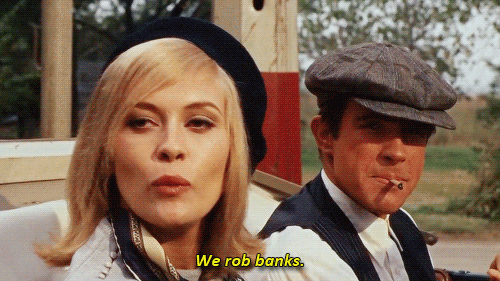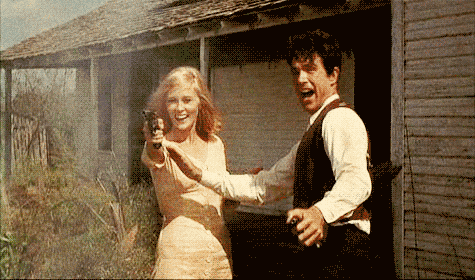This week in class, my group and I gave a presentation on “Singin’ in the Rain”. “Singin in the Rain” is 1952 film, doubling as a musical and a rom-com. It was directed and choreographed by Gene Kelley and Stanley Donen. The film shows behind the scenes of big movie production in Hollywood in the late 1920s, dealing with the transition from silent films to “talkies”. Starring Gene Kelley, Debbie Reynolds, and Donald O’Connar, the film gives amazing performances and an overall inflicts a “happy-go-lucky” feeling. I think very highly of this film, and am happy that this is the film that my group chose to present.  The main character in the film, Don Lockwood, is an actor, who also has a background in singing, dancing, and is a stunt man. Hs is matched with a young Hollywood actress for publicity for their movies, but this actress believes, despite being told multiple times otherwise, that her relationship with Don is real off screen as well. Don meets a showgirl, played by Debbie Reynolds, who becomes his new love interest, making his co-actress upset and jealous. The film goes on to show the shift in hollywood production as well as moving through the relationships of people who were involved in making that shift.
The main character in the film, Don Lockwood, is an actor, who also has a background in singing, dancing, and is a stunt man. Hs is matched with a young Hollywood actress for publicity for their movies, but this actress believes, despite being told multiple times otherwise, that her relationship with Don is real off screen as well. Don meets a showgirl, played by Debbie Reynolds, who becomes his new love interest, making his co-actress upset and jealous. The film goes on to show the shift in hollywood production as well as moving through the relationships of people who were involved in making that shift.
As for the reading this week, we learned about the “French New-Wave” in the 1950’s and 60’s. Around this time, the French filmmakers were making films that broke convention of what was allowed to be shown in film. This led to American filmmakers wanting in on the R-rated activity. In 1967, the MPAA’s Hay’s Code, restricting the use of violence and sexual content, was lifted; films were free to use much more risque shots. These films were more realistically shot, capturing things such as realistic looking bullet holes in someone who has just been shot, less modest sexual scenes, and more use of drugs. Critics in the 1960’s were all over the place in opinions of this film movement, some loved the films, and loved how much more believable and capturing they were with the removal of such tight restrictions on what could be shown. Other critics were not so fond of this new method, with their belief that these things have no reason to be shown to audiences.
On wednesday, our class had a screening of “Bonnie and Clyde” a 1967 American biographical crime film directed by Arthur Penn. The film stars Warren Beatty as Clyde Borrow and Faye Dunaway as Bonnie Parker. The film features Michael J. Pollard, Gene Hackman, and Estelle Parsons, with Denver Pyle, Dub Taylor, Gene Wilder. In the movie, Bonnie and Clyde are a couple who’s small acts of mischief turn into larger ones. The couple robs banks, and kills police officers. They meet when Clyde attempts to steal the car of a woman, who happens to be Bonnie’s mother. Bonnie at the time is bored with her life and her job as a waitress; she is intrigued by Clyde and decides to be his partner in crime. Throughout the movie, Bonnie and Clyde are shown throughout their entire relationship, portraying their kind personalities outside of the crimes they commit, and telling a story of two people falling in love. Together they kill police officers and bank tellers, while being very kind to others, showing sympathy and compassion; to me, Bonnie and Clyde were only out to fight real
car of a woman, who happens to be Bonnie’s mother. Bonnie at the time is bored with her life and her job as a waitress; she is intrigued by Clyde and decides to be his partner in crime. Throughout the movie, Bonnie and Clyde are shown throughout their entire relationship, portraying their kind personalities outside of the crimes they commit, and telling a story of two people falling in love. Together they kill police officers and bank tellers, while being very kind to others, showing sympathy and compassion; to me, Bonnie and Clyde were only out to fight real  problems in the world, the messed up police system, and capitalism. At the end of the film, the couple is at their happiest, having just decided that they were going to get married, when police massacre them, but not before they give each other a look of pure love and of knowing they have no regrets. The film was very good, and with knowing that this is a true story, it was much more upsetting to see the ending of the film.
problems in the world, the messed up police system, and capitalism. At the end of the film, the couple is at their happiest, having just decided that they were going to get married, when police massacre them, but not before they give each other a look of pure love and of knowing they have no regrets. The film was very good, and with knowing that this is a true story, it was much more upsetting to see the ending of the film.

I really enjoyed this week’s presentation. Your group did a great job showing us this film. I have not seen this film but have seen many clips from it. Your group and Professor really helped to show why this film was so important to the 60s. It really did help to bring more musical and dance to the big screen. Who knows what would have happened if this film didn’t exist? Would we miss out on some great musicals and lose a whole generation of kids who loved these films.
I wonder how some of these critics would feel if they watch some of the new movies for violence or crime. I bet some of them would walk out of a lot of Quentin Tarantino, movies just because of the blood. I know watching his film Django Unchained, I was shocked to see all the blood and how he used it as a point of the movies. The “French New Wave” is just one more thing that has help to bring films where they are today. Without this, I may never be interested in films because sometimes its lame not to see blood.
LikeLike
First off, I would like to say a good job on the presentation. It was a nice presentation and the movie seems really interesting. The film we watched this week, Bonnie and Clyde, was a good one. I loved it. I didn’t notice what they were really doing until you mentioned that they were fighting real problems. They were killing cops which because of the messed up police system and capitalism. It really sad how the movie ended. Bonnie and Clyde were in a very happy place, deciding to get married and run away and start a new life but the cops did not let that happen.
LikeLike
Very well written. I love your perspective on Bonnie and Clyde.
LikeLike